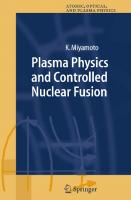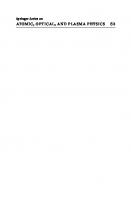Hadrons and Quark–Gluon Plasma (Cambridge Monographs on Particle Physics, Nuclear Physics and Cosmology, Series Number 18) 9781009290708, 9781009290753, 9781009290739, 1009290703
Before matter as we know it emerged, the universe was filled with the primordial state of hadronic matter called quark–g
132 68 4MB
English Pages 416
Table of contents :
Cover
Half-title page
Series page
Dedication page
Title page
Copyright page
Contents
Preamble
I A new phase of matter?
1 Micro-bang and big-bang
1.1 Energy and time scales
1.2 Quarks and gluons
1.3 The hadronic phase transition in the early Universe
1.4 Entropy-conserving (isentropic) expansion
1.5 The dynamic Universe
1.6 Looking for quark–gluon plasma: strangeness
1.7 Other probes of quark–gluon plasma
2 Hadrons
2.1 Baryons and mesons
2.2 Strange hadrons
2.3 Charm and bottom in hadrons
3 The vacuum as a physical medium
3.1 Confining vacuum in strong interactions
3.2 Ferromagnetic vacuum
3.3 Chiral symmetry
3.4 Phases of strongly interacting matter
3.5 The expanding fireball and phase transformation
3.6 QGP and confined hadronic-gas phases
4 Statistical properties of hadronic matter
4.1 Equidistribution of energy
4.2 The grand-canonical ensemble
4.3 Independent quantum (quasi)particles
4.4 The Fermi and Bose quantum gases
4.5 Hadron gas
4.6 A first look at quark–gluon plasma
II Experiments and analysis tools
5 Nuclei in collision
5.1 Heavy-ion research programs
5.2 Reaction energy and collision geometry
5.3 Rapidity
5.4 Pseudorapidity and quasirapidity
5.5 Stages of evolution of dense matter
5.6 Approachto local kinetic equilibrium
5.7 The approach to chemical equilibrium
6 Understanding collision dynamics
6.1 Cascades of particles
6.2 Relativistic hydrodynamics
6.3 The evolution of matter and temperature
6.4 Longitudinal flow of matter
7 Entropy and its relevance in heavy-ion collisions
7.1 Entropy and the approach to chemical equilibrium
7.2 Entropy in a glue-ball
7.3 Measurement of entropy in heavy-ion collisions
7.4 The entropy content in 200A-GeV S–Pb interactions
7.5 Supersaturated pion gas
7.6 Entropy in a longitudinally scaling solution
III Particle production
8 Particle spectra
8.1 A thermal particle source: a fireball at rest
8.2 A dynamic fireball
8.3 Incomplete stopping
8.4 Transverse-mass fireball spectra
8.5 Centrality dependence of m⊥-spectra
9 Highlights of hadron production
9.1 The production of strangeness
9.2 Hadron abundances
9.3 Measurement of the size of a dense-matter fireball
9.4 Production of transverse energy
9.5 RHIC results
IV Hot hadronic matter
10 Relativistic gas
10.1 Relation of statistical and thermodynamic quantities
10.2 Statistical ensembles and fireballs of hadronic matter
10.3 The ideal gas revisited
10.4 The relativistic phase-space integral
10.5 Quark and gluon quantum gases
10.6 Entropy of classical and quantum gases
11 Hadronic gas
11.1 Pressure and energy density in a hadronic resonance gas
11.2 Counting hadronic particles
11.3 Distortion by the Coulomb force
11.4 Strangeness in hadronic gas
11.5 The grand-canonical conservation of strangeness
11.6 Exact conservation of flavor quantum numbers
11.7 Canonical suppression of strangeness and charm
12 Hagedorn gas
12.1 The experimental hadronic mass spectrum
12.2 The hadronic bootstrap
12.3 Hadrons of finite size
12.4 Bootstrap withh adrons of finite size and baryon number
12.5 The phase boundary in the SBM model
V QCD, hadronic structure and high temperature
13 Hadronic structure and quantum chromodynamics
13.1 Confined quarks in a cavity
13.2 Confined quark quantum states
13.3 Nonabelian gauge invariance
13.4 Gluons
13.5 The Lagrangian of quarks and gluons
14 Perturbative QCD
14.1 Feynman rules
14.2 The running coupling constant
14.3 The renormalization group
14.4 Running parameters of QCD
15 Lattice quantum chromodynamics
15.1 The numerical approach
15.2 Gluon fields on the lattice
15.3 Quarks on the lattice
15.4 From action to results
15.5 A survey of selected lattice results
16 Perturbative quark–gluon plasma
16.1 An interacting quark–gluon gas
16.2 The quark–gluon liquid
16.3 Finite baryon density
16.4 Properties of a quark–gluon liquid
VI Strangeness
17 Thermal production of flavor in a deconfined phase
17.1 The kinetic theory of chemical equilibration
17.2 Evolution toward chemical equilibrium in QGP
17.3 Production cross sections for strangeness and charm
17.4 Thermal production of flavor
17.5 Equilibration of strangeness at the RHIC and SPS
18 The strangeness background
18.1 The suppression of strange hadrons
18.2 Thermal hadronic strangeness production
18.3 The evolution of strangeness in hadronic phase
19 Hadron-freeze-out analysis
19.1 Chemical nonequilibrium in hadronization
19.2 Phase space and parameters
19.3 SPS hadron yields
19.4 Strangeness as a signature of deconfinement
References
Index
Пустая страница
Cover
Half-title page
Series page
Dedication page
Title page
Copyright page
Contents
Preamble
I A new phase of matter?
1 Micro-bang and big-bang
1.1 Energy and time scales
1.2 Quarks and gluons
1.3 The hadronic phase transition in the early Universe
1.4 Entropy-conserving (isentropic) expansion
1.5 The dynamic Universe
1.6 Looking for quark–gluon plasma: strangeness
1.7 Other probes of quark–gluon plasma
2 Hadrons
2.1 Baryons and mesons
2.2 Strange hadrons
2.3 Charm and bottom in hadrons
3 The vacuum as a physical medium
3.1 Confining vacuum in strong interactions
3.2 Ferromagnetic vacuum
3.3 Chiral symmetry
3.4 Phases of strongly interacting matter
3.5 The expanding fireball and phase transformation
3.6 QGP and confined hadronic-gas phases
4 Statistical properties of hadronic matter
4.1 Equidistribution of energy
4.2 The grand-canonical ensemble
4.3 Independent quantum (quasi)particles
4.4 The Fermi and Bose quantum gases
4.5 Hadron gas
4.6 A first look at quark–gluon plasma
II Experiments and analysis tools
5 Nuclei in collision
5.1 Heavy-ion research programs
5.2 Reaction energy and collision geometry
5.3 Rapidity
5.4 Pseudorapidity and quasirapidity
5.5 Stages of evolution of dense matter
5.6 Approachto local kinetic equilibrium
5.7 The approach to chemical equilibrium
6 Understanding collision dynamics
6.1 Cascades of particles
6.2 Relativistic hydrodynamics
6.3 The evolution of matter and temperature
6.4 Longitudinal flow of matter
7 Entropy and its relevance in heavy-ion collisions
7.1 Entropy and the approach to chemical equilibrium
7.2 Entropy in a glue-ball
7.3 Measurement of entropy in heavy-ion collisions
7.4 The entropy content in 200A-GeV S–Pb interactions
7.5 Supersaturated pion gas
7.6 Entropy in a longitudinally scaling solution
III Particle production
8 Particle spectra
8.1 A thermal particle source: a fireball at rest
8.2 A dynamic fireball
8.3 Incomplete stopping
8.4 Transverse-mass fireball spectra
8.5 Centrality dependence of m⊥-spectra
9 Highlights of hadron production
9.1 The production of strangeness
9.2 Hadron abundances
9.3 Measurement of the size of a dense-matter fireball
9.4 Production of transverse energy
9.5 RHIC results
IV Hot hadronic matter
10 Relativistic gas
10.1 Relation of statistical and thermodynamic quantities
10.2 Statistical ensembles and fireballs of hadronic matter
10.3 The ideal gas revisited
10.4 The relativistic phase-space integral
10.5 Quark and gluon quantum gases
10.6 Entropy of classical and quantum gases
11 Hadronic gas
11.1 Pressure and energy density in a hadronic resonance gas
11.2 Counting hadronic particles
11.3 Distortion by the Coulomb force
11.4 Strangeness in hadronic gas
11.5 The grand-canonical conservation of strangeness
11.6 Exact conservation of flavor quantum numbers
11.7 Canonical suppression of strangeness and charm
12 Hagedorn gas
12.1 The experimental hadronic mass spectrum
12.2 The hadronic bootstrap
12.3 Hadrons of finite size
12.4 Bootstrap withh adrons of finite size and baryon number
12.5 The phase boundary in the SBM model
V QCD, hadronic structure and high temperature
13 Hadronic structure and quantum chromodynamics
13.1 Confined quarks in a cavity
13.2 Confined quark quantum states
13.3 Nonabelian gauge invariance
13.4 Gluons
13.5 The Lagrangian of quarks and gluons
14 Perturbative QCD
14.1 Feynman rules
14.2 The running coupling constant
14.3 The renormalization group
14.4 Running parameters of QCD
15 Lattice quantum chromodynamics
15.1 The numerical approach
15.2 Gluon fields on the lattice
15.3 Quarks on the lattice
15.4 From action to results
15.5 A survey of selected lattice results
16 Perturbative quark–gluon plasma
16.1 An interacting quark–gluon gas
16.2 The quark–gluon liquid
16.3 Finite baryon density
16.4 Properties of a quark–gluon liquid
VI Strangeness
17 Thermal production of flavor in a deconfined phase
17.1 The kinetic theory of chemical equilibration
17.2 Evolution toward chemical equilibrium in QGP
17.3 Production cross sections for strangeness and charm
17.4 Thermal production of flavor
17.5 Equilibration of strangeness at the RHIC and SPS
18 The strangeness background
18.1 The suppression of strange hadrons
18.2 Thermal hadronic strangeness production
18.3 The evolution of strangeness in hadronic phase
19 Hadron-freeze-out analysis
19.1 Chemical nonequilibrium in hadronization
19.2 Phase space and parameters
19.3 SPS hadron yields
19.4 Strangeness as a signature of deconfinement
References
Index
Пустая страница

- Author / Uploaded
- Jean Letessier
- Johann Rafelski









